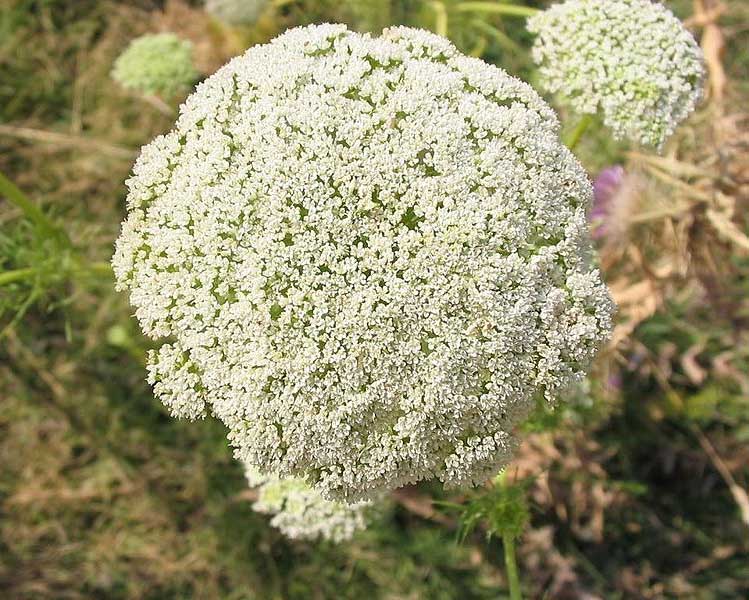
Visnaga daucoides (*)
Classification System: APG IV
Superregnum: Eukaryota
Regnum: Plantae
Cladus: Angiosperms
Cladus: Eudicots
Cladus: Core eudicots
Cladus: Asterids
Cladus: Campanulids
Ordo: Apiales
Familia: Apiaceae
Subfamilia: Apioideae
Tribus: Apieae
Genus: Visnaga
Species: Visnaga daucoides
Name
Visnaga daucoides Gaertn.
Synonyms
Ammi visnaga (L.) Lam.
Ammi visnaga var. longibracteatum Zohary
Apium visnaga (L.) Crantz
Carum visnaga (L.) Koso-Pol.
Daucus laevis Salisb.
Daucus visnaga L.
Selinum visnaga (L.) E. H. L. Krause
Sium visnaga (L.) Stokes
Visnaga vera Rafin.
References
Gaertner, J., Fruct. Sem. Pl. i 92. t. 21 (1788).
Links
Hassler, M. 2018. Visnaga daucoides. World Plants: Synonymic Checklists of the Vascular Plants of the World In: Roskovh, Y., Abucay, L., Orrell, T., Nicolson, D., Bailly, N., Kirk, P., Bourgoin, T., DeWalt, R.E., Decock, W., De Wever, A., Nieukerken, E. van, Zarucchi, J. & Penev, L., eds. 2018. Species 2000 & ITIS Catalogue of Life. Published on the internet. Accessed: 2018 Aug. 20. Reference page.
International Plant Names Index. 2018. Visnaga daucoides. Published online. Accessed: Aug. 20 2018.
The Plant List 2013. Visnaga daucoides in The Plant List Version 1.1. Published on the internet. Accessed: 2018 Aug. 20.
Tropicos.org 2018. Visnaga daucoides. Missouri Botanical Garden. Published on the internet. Accessed: 2018 Aug. 20.
Vernacular names
Deutsch: Bischofskraut, Khella, Khellakraut, Zahnstocherkraut, Zahnstocherammei, Ammei
English: Toothpickweed, Bisnaga, Khella
español: Bisnaga, Dauco Primero Silvestre, Escarbadientes, Marciaga, Pastinaca Bastarda, Visnaga, Visnaga Común, Visnaga Fina, Visnaga Real
suomi: Sirosudenporkkana
français: Ammi Visnage
polski: Aminek Egipski
slovenčina: parasca väčšia
Türkçe: Diş otu, Kürdan otu, Hıltan, Kılır
Ammi visnaga (syn. Visnaga daucoides, Daucus visnaga) is a species of flowering plant in the carrot family known by many common names, including toothpick-plant,[1] toothpickweed,[2] bisnaga, khella, or sometimes Bishop's weed. It is native to Europe, Asia, and North Africa, but it can be found throughout the world as an introduced species. This is an erect annual plant growing from a taproot to a maximum height near 80 centimeters. The leaves are up to 20 centimeters long and generally oval to triangular in shape but dissected into many small linear to lance-shaped segments. The inflorescence is a compound umbel of white flowers similar to those of other Apiaceae species. The fruit is a compressed oval-shaped body less than 3 millimeters long. This and other Ammi species are sources of khellin, a diuretic extract.
Like its close relative Ammi majus, A. visnaga is commonly seen in gardens where it is grown from seed annually.[3]
Traditional medicine
In Egypt, a tea made from the fruit of this species has been used as an herbal remedy for kidney stones.[4]
Preparations of Ammi visnaga fruits have also been used for angina pectoris therapy.[5]
Laboratory research
Laboratory rat studies show that the extract slows the buildup of calcium oxalate crystals in the kidneys and acts as a diuretic.[6][7] Its clinical effects in humans are unknown.
Chemical constituents
Khellin, a chemical compound obtained from A. visnaga, was used at one time as a smooth muscle relaxant, but its use is limited due to adverse side effects.[8] Amiodarone and cromoglycate are synthetic derivatives of khellin with fewer side effects which were developed for use in modern medicine.[medical citation needed]
Visnagin is another chemical compound - toxic if ingested in the pure state - which is found in A. visnaga.[9] Visnadine is a natural vasodilator found in A. visnaga.
References
BSBI List 2007 (xls). Botanical Society of Britain and Ireland. Archived from the original (xls) on 2015-06-26. Retrieved 2014-10-17.
"Ammi visnaga". Natural Resources Conservation Service PLANTS Database. USDA. Retrieved 8 January 2016.
"Growing Ammi visnaga and Ammi majus from seed". higgledygarden.com. 2015-01-07. Retrieved 12 January 2018.
Azim Khan, Muhammad (2014). "Phytochemistry and Medicinal Properties of Ammi Visnaga". Pak. J. Bot. 46 (3): 861–867.
Waltenberger, B; Mocan, A; Šmejkal, K; Heiss, EH; Atanasov, AG (2016). "Natural Products to Counteract the Epidemic of Cardiovascular and Metabolic Disorders". Molecules. 55 (6): 555. doi:10.3390/molecules21060807. PMC 4928700. PMID 27338339.
Vanachayangkul, P.; et al. (2010). "An aqueous extract of Ammi visnaga fruits and its constituents khellin and visnagin prevent cell damage caused by oxalate in renal epithelial cells". Phytomedicine. 17 (8): 653–58. doi:10.1016/j.phymed.2009.10.011. PMC 3618668. PMID 20036111.
Khan, Z. A.; et al. (2001). "Inhibition of oxalate nephrolithiasis with Ammi visnaga (AI-Khillah)". International Urology and Nephrology. 33 (4): 605–8. doi:10.1023/A:1020526517097. PMID 12452606. S2CID 12832121.
Ziment, I (1998). "How your patients may be using herbalism to treat their asthma - Herbal products are becoming increasingly popular for treating a variety of medical complaints - including asthma. What are these". Journal of Respiratory Diseases. 19 (12): 1070–83.
Lee, J. K.; et al. (November 2010). "Anti-inflammatory effect of visnagin in lipopolysaccharide-stimulated BV-2 microglial cells". Archives of Pharmacal Research. 33 (11): 1843–50. doi:10.1007/s12272-010-1117-1. PMID 21116788. S2CID 22168754.
Retrieved from "http://en.wikipedia.org/"
All text is available under the terms of the GNU Free Documentation License

